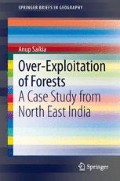Abstract
The seven states of Arunachal Pradesh, Assam, Manipur, Meghalaya, Mizoram, Nagaland, and Tripura make up north east India. The region spreads over 255,037 km2 or about 7.7 % of India’s total geographical area. The relief is rugged with plateaus, hills and mountains dominating. Level lowlands are at a premium covering only 27 % of the area. Rainfall is torrential with 6,300 mm annually a routine occurrence in the Cherrapunji area. In the rest of the region, average annual precipitation ranges from 1,000 to over 4,000 mm with the bulk of it occurring during the monsoon months of June to October. Stemming from this a luxuriant tropical vegetation ranging from alpine, subtropical pine and montane to evergreen and moist deciduous thrives making the region a global biodiversity hotspot. The focus of development in has centred around its primary resource base, largely around tea, timber and petroleum. What little else exists in the name of development has been concentrated in the urban landscapes. It is not surprising that in the region’s rural areas a dependence on natural resources—forests in particular—exists and there is not much option than to exploit the region’s forest resources.
Access this chapter
Tax calculation will be finalised at checkout
Purchases are for personal use only
References
Arunachalam A, Sarmah R, Adhikari D, Majumdar M, Khan ML (2004) Anthropogenic threats and biodiversity conservation in Namdapha nature reserve in the Indian eastern himalayas. Curr Sci 87:447–454
Barthakur M (1986) Weather and climate of north east India. North East Geogr 18:20–27
Bhakta GP (1991) Geography of Meghalaya. Akashi Book Depot, Shillong
Brown D, Schreckenberg K (1998) Shifting cultivators as agents of forest degradation: assessing the evidence. Natural Resource Perspectives Number 29. Overseas Development Institute, London
Das HP, Singh DK, Sharma HN (1971) Meghalaya-Mikir Region In: Singh RL (ed) India: a regional geography. National Geographical Society of India, Varanasi
Ellis EC, Ramankutty N (2008) Putting people in the map: anthropogenic biomes of the world. Front Ecol Environ 6:439–447. doi:10.1890/070062
Gopalakrishnan R (1991) The north east India: land, economy and people. Har-Anand, New Delhi
Hazarika R, Saikia A (2013) The pachyderm and the pixel: an assessment of elephant habitat suitability in Sonitpur, India. Int J Remote Sens 34:5317–5330. doi:10.1080/01431161.2013.787503
Kashyap SC (1990) National forest policy. In: Kashyap SC (ed) National policy studies. Tata McGraw Hill, New Delhi
Lele N, Joshi PK (2009) Analyzing deforestation rates, spatial forest cover changes and identifying critical areas of forest cover changes in north-east India during 1972–1999. Environ Monit Assess 156:159–170. doi:10.1007/s10661-008-0472-6
Prasad J (1971) Eastern himalaya. In: Singh RL (ed) India: a regional geography. National Geographical Society of India, Varanasi
Saikia A, Hazarika R, Sahariah D (2013) Land use land cover change and fragmentation in the Nameri Tiger Reserve, India. Geogr Tidsskr-Dan J Geogr 113:1–10. doi:10.1080/00167223.2013.782991
SFR (1996) State Forest Report 1995. FSI, Ministry of Environment & Forests, Government of India, Dehra Dun
SFR (1998) State Forest Report 1997. FSI, Ministry of Environment & Forests, Government of India, Dehra Dun
SFR (2000) State Forest Report 1999. FSI, Ministry of Environment & Forests, Government of India, Dehra Dun
SFR (2008) State Forest Report 2005. FSI, Ministry of Environment & Forests, Government of India, Dehra Dun
SFR (2009) State of Forest Report 2009. FSI, Ministry of Environment & Forests, Government of India, Dehra Dun
Taher M (1986) Physiographic framework of north east India. North East Geogr 18:1–19
Tisdell C, Roy K (1997) Sustainability of land use in north-east India: issues involving economics, the environment and biodiversity. Int J Soc Econ 24:160–177. doi:10.1108/03068299710161188
Tucker RP (1988) The depletion of India’s forests under British imperialism: planters, foresters, and peasants in Assam and Kerala. In: Worster D (ed) The ends of the earth : perspectives on modern environmental history. Cambridge University Press, Cambridge
Tucker RP (1988a) The British empire and India’s forest resources: the timberlands of Assam and Kumaon 1914-1950. In: Richards JF, Tucker RP (eds) World deforestation in the twentieth century. Duke University Press, Durham and London
Acknowledgments
The population map of North East India was prepared utilizing the LandScan (2008)™ High Resolution global Population Data Set copyrighted by UT-Battelle, LLC, operator of Oak Ridge National Laboratory under Contract No. DE-AC05-00OR22725 with the United States Department of Energy. The United States Government has certain rights in this Data Set. The United States Government has certain rights in this Data Set. Neither UT-BATTELLE, LLC NOR THE UNITED STATES DEPARTMENT OF ENERGY, NOR ANY OF THEIR EMPLOYEES, MAKES ANY WARRANTY, EXPRESS OR IMPLIED, OR ASSUMES ANY LEGAL LIABILITY OR RESPONSIBILITY FOR THE ACCURACY, COMPLETENESS, OR USEFULNESS OF THE DATA SET.
Author information
Authors and Affiliations
Corresponding author
Rights and permissions
Copyright information
© 2014 The Author(s)
About this chapter
Cite this chapter
Saikia, A. (2014). The Study Area. In: Over-Exploitation of Forests. SpringerBriefs in Geography. Springer, Cham. https://doi.org/10.1007/978-3-319-01408-1_2
Download citation
DOI: https://doi.org/10.1007/978-3-319-01408-1_2
Published:
Publisher Name: Springer, Cham
Print ISBN: 978-3-319-01407-4
Online ISBN: 978-3-319-01408-1
eBook Packages: Earth and Environmental ScienceEarth and Environmental Science (R0)

